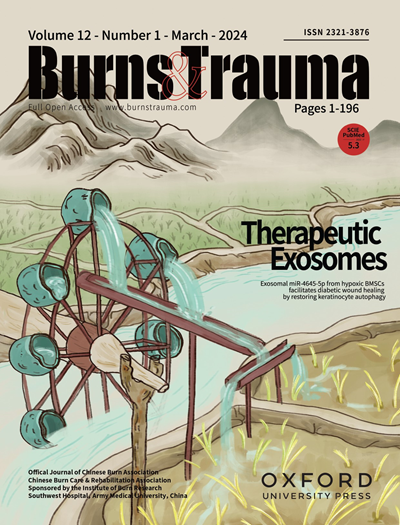聚焦校正飞秒激光消融在微米级精确去除不均匀皮肤组织
IF 9.6
1区 医学
Q1 DERMATOLOGY
引用次数: 0
摘要
从美容外科和再生医学的角度来看,在皮肤清创和去除多余组织等手术过程中,手术器械的精度对于预防美学并发症以及更好的再生至关重要。飞秒激光(fs-激光器)可以实现微米级的组织去除。然而,不均匀的皮肤纹理会导致激光离焦,导致医源性损伤,阻碍临床应用。因此,克服光纤激光器的散焦倾向对其临床应用至关重要。方法利用自主开发的fs激光微加工平台,采用不同的激光功率和速度对猪皮进行线性、平面和三维扫描,实现了基于二维插值的猪皮表面聚焦校正方法。利用确定的剂量-反应关系,优化的装置和参数在大鼠体内实验中用于精确组织消融。组织学评估剩余皮肤的结构完整性和活力。结果本研究表明,聚焦校正的fs激光消融可以实现可控的微米级目标皮肤组织去除。组织切除深度与fs激光单脉冲能量相关。与其他激光器件不同,扫描速度不影响烧蚀深度,因为焦校正fs激光器的聚焦机制限制了烧蚀超出焦点。适当的fs激光参数平行线性扫描使组织去除在各种三维形状。增加的景深、增加的单脉冲能量和更快的扫描速度使大鼠模型中皮肤组织的精确、快速和安全消融成为可能。组织学和生化分析表明,病灶校正的激光清创不会损害周围的胶原结构或伤口的细胞活力。结论:我们证明了聚焦校正的fs激光消融能够以最小的附带损伤实现微米尺度的皮肤去除。通过选择性地调整单脉冲能量,以最大允许的扫描速度进行深度特异性消融和手术,该技术能够以所需的形状精确去除皮肤,为皮肤以及其他组织或器官手术提供创新和超高精度的手术方法。本文章由计算机程序翻译,如有差异,请以英文原文为准。
Precision Removal of Uneven Skin Tissue at the Micrometer Level via Focus-Corrected Femtosecond-Laser Ablation
Background From the perspective of aesthetic surgery and regenerative medicine, the precision of surgical instruments is critical for preventing aesthetic complications during procedures such as skin debridement and the removal of unwanted tissues, as well as for better regeneration. Femtosecond lasers (fs-lasers) can achieve micrometer-level tissue removal. However, an uneven skin texture can cause the laser to defocus, leading to iatrogenic injury and hindering clinical application. Overcoming the defocusing tendency of fs-lasers is therefore crucial for their clinical use. Methods Our self-developed fs-laser microfabrication platform was used to implement a focus-corrected method based on two-dimensional interpolation for uneven skin surfaces, using different laser powers and velocities for linear, planar, and three-dimensional scanning of porcine skin. Leveraging the identified dose–response relationship, the optimized device and parameters were used for precise tissue ablation in an in vivo rat experiment. The structural integrity and viability of the remaining skin were evaluated histologically. Results Our study revealed that focus-corrected fs-laser ablation enabled controllable micrometer-level removal of target skin tissues. The depth of tissue removal was correlated with the fs-laser single-pulse energy. Unlike other laser devices, the scanning velocity did not affect the ablation depth, as the focusing mechanism of the focus-corrected fs-laser restricts ablation beyond the focal point. Appropriate fs-laser parameters for parallel linear scanning enabled tissue removal in various three-dimensional shapes. Increased depth of field, increased single-pulse energy, and faster scanning velocity enabled precise, rapid, and safe ablation of skin tissue in the rat model. Histological and biochemical analyses demonstrated that focus-corrected fs-laser debridement did not damage the surrounding collagen structure or cell viability of the wound. Conclusions We demonstrated that focus-corrected fs-laser ablation enables micron-scale skin removal with minimal collateral damage. By selectively adjusting single-pulse energy for depth-specific ablation and operation at the maximum permissible scanning velocity, this technique enables precise skin removal in the desired shape, offering an innovative and ultrahigh-precision surgical approach for skin as well as other tissues or organ surgery.
求助全文
通过发布文献求助,成功后即可免费获取论文全文。
去求助
来源期刊

Burns & Trauma
医学-皮肤病学
CiteScore
8.40
自引率
9.40%
发文量
186
审稿时长
6 weeks
期刊介绍:
The first open access journal in the field of burns and trauma injury in the Asia-Pacific region, Burns & Trauma publishes the latest developments in basic, clinical and translational research in the field. With a special focus on prevention, clinical treatment and basic research, the journal welcomes submissions in various aspects of biomaterials, tissue engineering, stem cells, critical care, immunobiology, skin transplantation, and the prevention and regeneration of burns and trauma injuries. With an expert Editorial Board and a team of dedicated scientific editors, the journal enjoys a large readership and is supported by Southwest Hospital, which covers authors'' article processing charges.
 求助内容:
求助内容: 应助结果提醒方式:
应助结果提醒方式:


